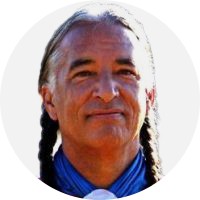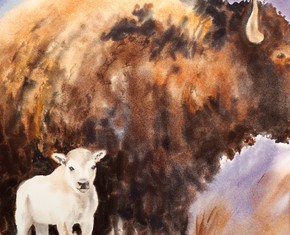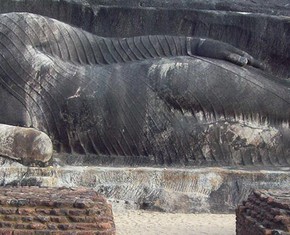The views expressed in our content reflect individual perspectives and do not represent the authoritative views of the Baha'i Faith.
One of the most influential books on Indigenous spirituality, 1937’s The Gospel of the Redman by Ernest Thompson Seton and Julia M. Seton, has been both celebrated and criticized.
Ernest Seton, (1860–1946), was a renowned naturalist, artist, and famous teller of animal stories such as the Wild Animals I Have Known, Animal Heroes, and Lives of the Hunted. Seton founded the Woodcraft Movement and co-founded the Boy Scouts of America.
RELATED: Indigenous Transformers: Heroes, Tricksters, Monsters, and Caretakers
The Seton’s book The Gospel of the Redman, a White expression of Indigenous thought, based the authenticity, integrity, and accuracy of its representations of Indigenous American teachings and ways of life on the information they gleaned from several close friendships with Native Americans and Native Canadians, who served as sources of knowledge and experience regarding all things Indigenous. Ernest Seton’s most influential Indigenous teacher was Dr. Charles Alexander Eastman, known as Ohiyesa, of the Santee Sioux from Minnesota.
Many native people have praised Seton’s book. In 2006, for example, reviewer Kim Pappin, an enrolled member of the Osage Nation, who works for the Southern Ute Tribe at KSUT Four Corners Public Radio, praised The Gospel of the Redman:
Seton imparts teachings of Hiawatha, Crazy Horse, Sitting Bull, Tecumseh, Black Hawk, and Geronimo. And he offers many Indian prayers that provide evidence of the profound relationship between Native Americans and their Creator. I enjoyed reading this book very much, it made me appreciate Native philosophy even more, but I found the knowledge shared what I already know on a deep, instinctual level.
Kevin, you recently called my attention to a very interesting connection between The Gospel of the Redman and William Sears, a prominent Baha’i in his time, who was appointed a “Hand of the Cause of God” by the Baha’i Guardian Shoghi Effendi. (The Baha’i Encyclopedia Project explains that the “Hands of the Cause of God” represent an “… administrative institution … charged with the functions of protecting and propagating the Baha’i Faith; the generative body for one of two parallel lines of responsibility in Baha’i administration.”) Much to my surprise, Routledge – the publisher of my introductory book, Baha’i Faith: The Basics, recently republished Revival: The Gospel of the Redman (1937): An Indian Bible.
In July of 1962, William Sears spoke at the Poorman Reserve — now known as the Kawacatoose Reserve (Cree) — in southeast Saskatchewan, Canada. As published in American Indians and the Baha’i Faith by the Baha’i author Littlebrave Beaston (who also wrote a biography of your late, great mother, Kevin — Warrior Grandma: The Story of Patricia Locke), Mr. Sears told about his influential encounter with the Seton’s book:
One afternoon while I was walking along the side of the sacred Mountain [Mt. Carmel, Haifa, Israel], where the feet of Christ and the Prophets of old had walked, I was handed a small book. It was called: The Gospel of the Redman, written by Ernest Thompson Seaton. It had been brought to me from here, Canada, by Mr. Balyuzi, a much loved figure of the Baha’i Faith. Mr. Balyuzi had just returned from a visit to Saskatchewan, and to the American Indians in many other places. He was so filled with love and respect for those whom he had met that, following a visit, he brought me the book, The Gospel of the Redman. It contained, he said, many of the basic principles of the people he had come to admire so greatly.
When I had finished reading The Gospel of the Redman, I understood what Mr. Balyuzi meant. I began to write a letter to each one of the many followers of Baha’u’llah and the Baha’i Faith among the American Indians in both North and South America. Little did I think at the time that I might have the pleasure of sharing that letter with you in person. Circumstances have brought me to the Western world, for which I thank Almighty God, the Great Spirit of us all.
I realize, of course, that the book, The Gospel of the Redman, does not apply in every detail equally to all parts of North and South America, or equally to all Tribes of American Indians. It is, however, a leaf in the stream which shows the direction of the current.
Yet the thoughts expressed in that book clearly showed the lofty station and great dignity of the American Indian. It also showed me, as a Baha’i, that they were truly a “prepared people” in whose hearts the Teachings of Baha’u’llah had already taken root, whether consciously or unconsciously. I realized how very little the other parts of the world know about this wonderful people assembled here today.
Therefore, I arranged to send my letter to the more than 250 countries, dependencies and islands where the Baha’i Faith had been established, that people in all parts of the planet may understand and come to know the greatness and nobility of the American Indian.
However The Gospel of the Redman may be seen now, the book seems to have been regarded as an authority in its day, even by the Kawacatoose people themselves, since we can infer that The Gospel of the Redman was given to Mr. Balyuzi during his visit to Saskatchewan.
RELATED: Why We Call the Prophets by Different Names
Of course, the central figures of the Baha’i Faith urged humanity to unite, regardless of their racial, religious, or ethnic backgrounds. In a speech he gave to an integrated audience in Washington, D.C. in 1912, Abdu’l-Baha said:
The love of Baha’u’llah is in your hearts. Your souls are rejoicing in the glad tidings of Baha’u’llah. My hope is that the white and the black will be united in perfect love and fellowship, with complete unity and brotherhood. Associate with each other, think of each other, and be like a rose garden. Anyone who goes into a rose garden will see various roses, white, pink, yellow, red, all growing together and replete with adornment. Each one accentuates the beauty of the other. Were all of one color, the garden would be monotonous to the eye. If they were all white or yellow or red, the garden would lack variety and attractiveness; but when the colors are varied, white, pink, yellow, red, there will be the greatest beauty. Therefore, I hope that you will be like a rose garden. Although different in colors, yet – praise be to God! – you receive rays from the same sun. From one cloud the rain is poured upon you. You are under the training of one Gardener, and this Gardener is kind to all. Therefore, you must manifest the utmost kindness towards each other …
I hope you will continue in unity and fellowship. How beautiful to see blacks and whites together! I hope, God willing, the day may come when I shall see the red men, the Indians, with you, also Japanese and others. Then there will be white roses, yellow roses, red roses, and a very wonderful rose garden will appear in the world.
Kevin, am I right in thinking what William Sears did — by sending his letter “to the more than 250 countries, dependencies and islands where the Baha’i Faith had been established” — not only followed the admonitions of Abdu’l-Baha but also represented a significant initiative among the Baha’is?
A: Yes! As Baha’is, we know that it is highly significant that a Hand of the Cause of God, Hasan Balyuzi, gave a copy of The Gospel of the Redman to his fellow Hand of the Cause of God, William Sears, who, in turn, chose to share this information with the entire Baha’i world. Mr. Sears was moved to compose and share this message in response to the first large population to enter the Baha’i Faith in North America — the Indigenous peoples of the northern plains.
Mr. Sears drew the attention of the Baha’i world to the clear congruence between the North American spiritual heritage and the Baha’i teachings, as elaborated in The Gospel of the Redman. I believe you and I, in our exploration of Indigenous messengers of God, are tracing the same well-worn path trod by such luminaries as William Sears and Hand of the Cause of God Ruhiyyih Khanum, in connecting all people to the divine legacy of our beloved North American homeland.
That these three prominent Baha’is saw so much affinity between Indigenous sacred traditions and the Baha’i teachings, and that two of them, William Sears and Ruhiyyih Khanum, sought to reach out to the Indigenous peoples of the Americas, is quite noteworthy. It sets a precedent for you and I, and others, of course, to emulate and carry further forward today.
Q: Kevin, let’s take a look at some of the Indigenous spiritual principles that William Sears cited from The Gospel of the Redman:
To demonstrate the close link of love and truth that binds together the beautiful truth of the American Indian with the Teachings of the Baha’i Faith of Baha’u’llah, I have written down the four main points of what The Gospel of the Redman called: The Indian Creed. It is, of course, only possible to speak of it briefly here.
First Point: “There is but one Great Spirit, the Creator and Ruler of all things, to Whom we are responsible. He is eternal, invisible, omnipotent, unportrayable. In and through Him all beings live and move; to Him all worship and allegiance are due; from Him all good things come.”
Second Point: “Having arrived on this earth, the First duty of man is the attainment of perfect manhood, which is the just development of every part and power that goes to make a man, and the fullest reasonable enjoyment of the same. He must achieve manhood in the Body Way, the Mind Way, the Spirit Way, and the Service Way.”
Third Point: “Having attained to high manhood, he must consecrate that manhood to the service of his people.”
Fourth Point: “The Soul of man is immortal. Whence it came into this world or whither it goes when it departs, he does not know. But when his time comes to die, he should remember that he is going on to the next world.”
In the next installment of our series of essays, we’ll continue our conversation about The Gospel of the Redman, and explore how Indigenous spiritual traditions resonate and harmonize with the Baha’i teachings.

















Comments
Sign in or create an account
Continue with Googleor